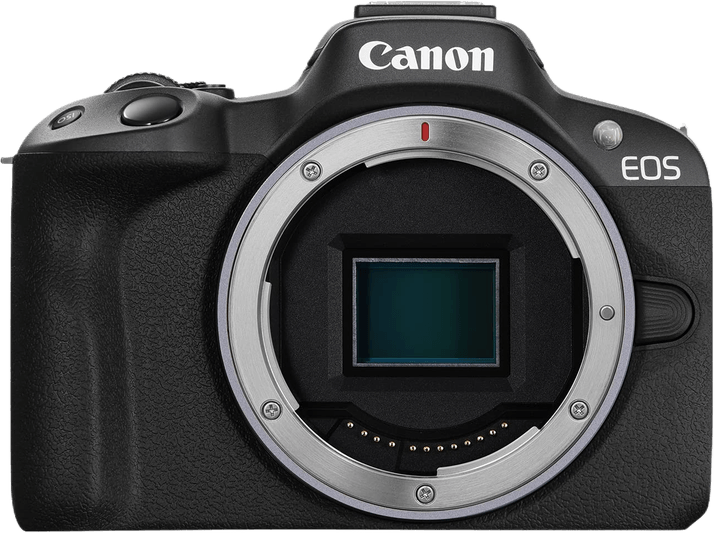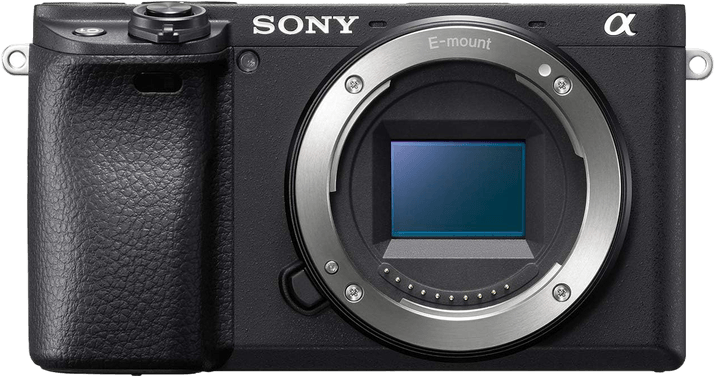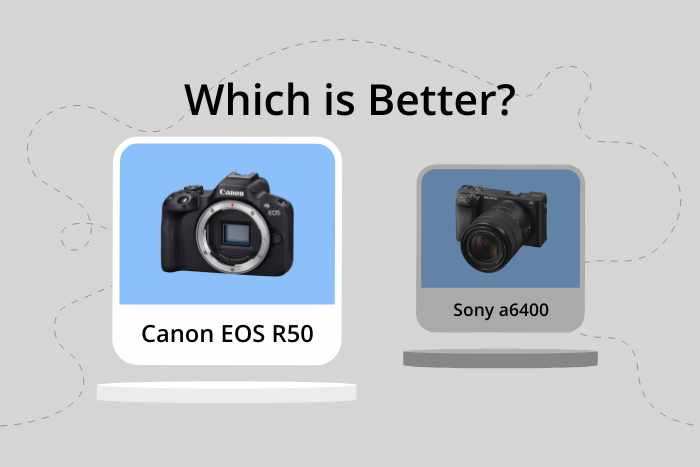Canon EOS R50 vs Sony a6400 Comparison
Canon EOS R50

Sony a6400

The Canon EOS R50 and Sony a6400 both receive a score of 70/100, indicating that they are equally matched in terms of general specifications. Both cameras are mirrorless and share similar launch prices, with the Canon EOS R50 priced at $679 and the Sony a6400 at $900.
In terms of size, the Canon EOS R50 measures 116 x 86 x 69mm and weighs 375g, making it slightly lighter than the Sony a6400, which measures 120 x 67 x 60mm and weighs 403g. The lighter weight of the Canon EOS R50 is an advantage for those seeking a more portable camera.
On the other hand, the Sony a6400 has been on the market since 2019, giving it a longer track record and potentially more user feedback. This could be seen as an advantage for those who prefer tried-and-tested products.
Both cameras offer solid general specifications, with the Canon EOS R50 being a better choice for those valuing portability, while the Sony a6400 may appeal to those seeking a proven option.
Canon EOS R50 vs Sony a6400 Overview and Optics
The Canon EOS R50 outperforms the Sony a6400 in optics, with a score of 73/100 compared to the Sony’s 68/100. Both cameras share several optical specifications, such as 24 megapixels, CMOS sensors, APS-C sensor sizes, and lack of image stabilization. Additionally, both cameras use different processors: the Canon EOS R50 with a Digic X processor and the Sony a6400 with a Bionz X processor.
The Canon EOS R50 excels in its DXOMARK sensor score of 94, which is higher than the Sony a6400’s score of 83. This higher score means that the Canon EOS R50’s sensor performs better in terms of color depth, dynamic range, and low-light performance. Moreover, the Canon EOS R50 has a faster shooting speed of 12 frames per second (fps), compared to the Sony a6400’s 11 fps. This gives the Canon EOS R50 an advantage in capturing fast-moving subjects.
On the other hand, the Sony a6400 has a slightly higher megapixel count of 24.2, compared to the Canon EOS R50’s 24. However, this small difference is not significant enough to make a noticeable impact on image quality. Both cameras lack image stabilization, so neither has an advantage in this area. The Sony a6400 uses the Sony E lens mount, while the Canon EOS R50 uses the Canon RF mount, which may be a consideration for users with existing lenses or brand preference.
Considering these factors, the Canon EOS R50 is the superior camera in terms of optics due to its higher DXOMARK sensor score and faster shooting speed. Although the Sony a6400 has a slightly higher megapixel count, the difference is not significant enough to outweigh the advantages of the Canon EOS R50.
Canon EOS R50 vs Sony a6400 Video Performance
The Canon EOS R50 and Sony a6400 both have a video score of 91/100, indicating their strong video capabilities. Both cameras share key features, such as a maximum video resolution of 4K, dimensions of 3840 x 2160, and a frame rate of 120fps. Additionally, both the EOS R50 and a6400 have built-in time-lapse functionality.
The Canon EOS R50 excels in its user-friendly interface, making it easier for beginners and professionals alike to navigate and adjust settings. This advantage allows users to focus on capturing high-quality video without getting bogged down in complex menus and settings. The EOS R50 also has a larger sensor, leading to better low-light performance and overall image quality.
On the other hand, the Sony a6400 offers advantages such as faster autofocus and more autofocus points, which can be beneficial for capturing fast-moving subjects and ensuring sharp focus throughout the video. This feature is particularly useful for sports and wildlife videography.
In terms of video capabilities, both the Canon EOS R50 and Sony a6400 perform exceptionally well, with identical scores and shared specifications. The EOS R50 stands out for its user-friendly interface and better low-light performance, while the a6400 excels in autofocus capabilities. Ultimately, the choice between these two cameras depends on the specific needs and preferences of the videographer, as both cameras offer impressive video performance.
Canon EOS R50 vs Sony a6400 Features and Benefits
The Sony a6400 wins the features comparison with a score of 81/100, while the Canon EOS R50 scores 72/100. Both cameras have several specs in common, which include a 3-inch touchscreen, flip screen, and wireless connectivity options like WIFI and Bluetooth. Neither camera features GPS.
The Sony a6400 excels in terms of screen resolution, boasting 921,600 dots compared to the Canon EOS R50’s 1,620,000 dots. This higher resolution provides the Sony a6400 users with a clearer and more detailed view of their images and videos during playback and live view, enhancing the overall shooting experience.
On the other hand, the Canon EOS R50 does not have any significant advantages over the Sony a6400 in the features department. Both cameras share essential features that cater to modern photography needs, such as touchscreens, flip screens, and wireless connectivity options.
Based on this comparison, the Sony a6400 emerges as the better camera in terms of features. It offers a higher screen resolution, which improves the user experience while maintaining the same essential features as the Canon EOS R50. Meanwhile, the Canon EOS R50 does not provide any additional benefits over the Sony a6400. As a result, the Sony a6400 is the recommended choice for those prioritizing camera features and overall performance.
Canon EOS R50 vs Sony a6400 Storage and Battery
The Sony a6400 edges out the Canon EOS R50 in storage and battery, scoring 37/100 compared to the R50’s 35/100. Both cameras share some common specifications, such as having one memory card slot and USB charging capabilities. They also accept SD/SDHC/SDXC memory cards, with the a6400 additionally compatible with Memory Stick Duo cards.
The a6400’s advantage lies in its longer battery life of 410 shots, compared to the R50’s 370 shots. This difference allows users to take more photos without needing to recharge or replace the battery. The a6400 also supports a wider range of memory cards, offering more flexibility in storage options.
Conversely, the Canon EOS R50 is compatible with both UHS-I and II SD cards, providing faster read and write speeds. This feature is beneficial for users who require quicker data transfer, especially when dealing with large files.
While both cameras offer decent storage and battery performance, the Sony a6400’s longer battery life and broader memory card compatibility make it a more versatile option. However, the Canon EOS R50’s compatibility with faster SD cards could be a deciding factor for those prioritizing speed.
Canon EOS R50 vs Sony a6400 Alternatives
Are you considering buying or upgrading from a Canon EOS R50 or a Sony a6400? Our camera comparison tool can help you weigh up its price and performance against the competition.
Here are some related popular camera comparisons to check for inspiration:

